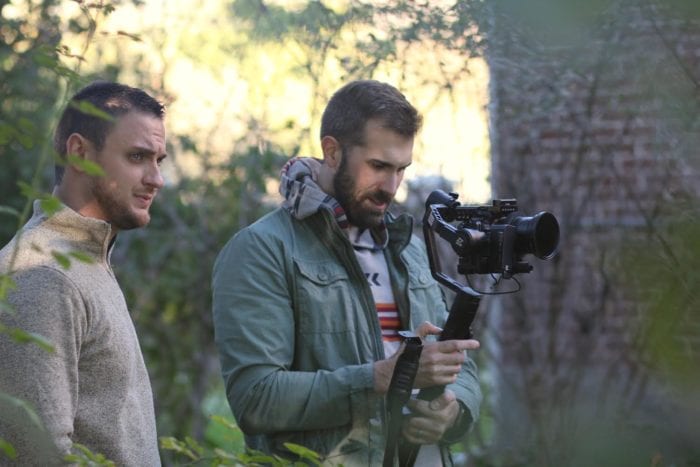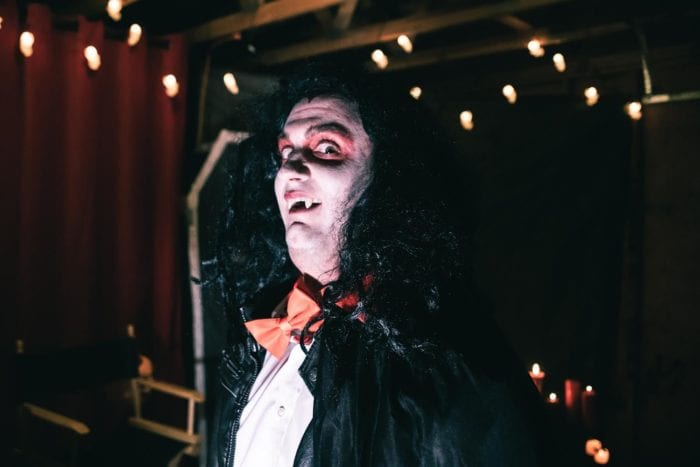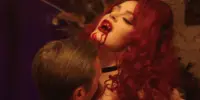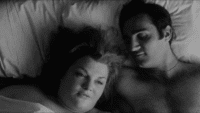In the creative world, be it art or music, film or fiction, having a like-minded friend is a must: someone who understands your brand of functional insanity, the icky goo all good endeavors of the imagination leap out from. I’ve been fortunate enough to have found such a compatriot of the macabre in writer/director Michael Ballif. It’s a great thing we’ve got going, despite our near cross-country distance. I send him my fiction, he lets me peek behind the mystical curtain at his many marvelous cinematic endeavors. Ballif’s debut feature film, They Live Inside Us, just dropped on Amazon’s Prime Video this past week. I caught up with my friend to ask him a few questions about the film and give you, dear reader, a glimpse behind that aforementioned mystical curtain.
Let’s take a look together, shall we?
Donnie Kirchner: They Live Inside Us has just been released on Prime Video. With a wider audience eyeing up the film as of late, let’s talk about the long road and dedication that got you to this place. Walk me through the timeline of how They Live Inside Us came to be.
Michael Ballif: This was my first feature-length movie, so it has pretty much been in the making since the day I first picked up my parents’ camcorder and started making crappy little movies as a kid. I came up with the concept for the film maybe eight or nine years ago. It’s funny to think about now, but at the time, I had been putting enormous pressure on myself to get a movie made before I reached a certain age. I was in my early 20s and had been comparing myself to filmmakers I looked up to like Sam Raimi who made The Evil Dead at the insanely young age of 19. I tried my best to make the project happen, but for a variety of reasons, I ultimately realized I just wasn’t ready. I decided rather than trying to force it, I’d do something else to hopefully prepare myself for that next step.

I started to really like the idea of doing an anthology series because it would enable me to create multiple short films that could tie together into one big, singular project. In retrospect, it’s kind of amazing just how much The Witching Season did to prep me for They Live Inside Us. It not only led to the necessary networking opportunities for my eventual cast, crew, locations, and even my poster artist, but it also became the launchpad for my production company Witching Season Films. The support we were able to garner through YouTube and social media eventually led to a successful crowdfunding campaign, which gave us the small budget needed for the movie. It even enabled me to test the idea for the film itself as a proof of concept short film, which became the fourth episode of the series.
Once our crowdfunding campaign was complete, we forged ahead with production. Filming took almost exactly a year, shooting primarily on weekends, usually one to two days per week. Even though shooting on weekends was a bit of a challenge for the sake of continuity and maintaining momentum, it also offered me the luxury of being able to edit as we were shooting. This meant I was able to spend the following week working on the edit to get a feel for how things were flowing. I was pretty much re-writing the script constantly as we went, so working this way gave me some flexibility to adjust the story when new ideas would come up. By the time we wrapped shooting, I had a full cut of the film already ready to look at. A few months after this, my team and I held a cast/friends/family test screening that we used to get feedback. I took that feedback and spent the next few months tightening the edit, doing the final color correction, and finishing with the final sound design and mixing. Throughout the entire process, I relied heavily on my producers James Morris, Allen Bradford, and Jordan Swenson for feedback. We held a handful of screenings together where they could look at the cut objectively and give me notes, which was majorly helpful as I had lost all objectivity at that point. Once we had a finished cut, we took it out to distributors and eventually secured a deal with Gravitas Ventures for a worldwide release.
DK: Considering the scope of the film, you and your team did an astonishing job putting forth a piece of work that feels like it has double, triple that modest, crowdfunded budget. What areas of the filmmaking process—trying to deliver your vision on a shoestring—did you find most valuable for future work?
Michael Ballif: I think it really came down to writing a script that we could realistically pull off with what we had at our disposal. Thanks to our crowdfunding, we had a little bit of money to upgrade a few pieces of gear, pay everyone, and cover food expenses. Beyond that, we really needed to get creative to find locations, props, wardrobe, etc. that we could pull together either for free or affordably. With TLIU we also had the luxury of doing the short film first, so we had a handful of contacts and relationships we could turn to for help. We called in all the favors we could but never made any sacrifices that would potentially lessen the quality of the movie. Myself and my team all wore a ton of hats too, so rather than hiring a 20-person crew, we kept the crew at around 2-4 people on a given day. There were days when it was literally just me and James going down to the house to film small scenes. It was really only possible because we were honest with ourselves when we designed and planned the movie from the outset.

DK: A few faces in TLIU will be familiar to anyone who’s seen some of your other work. As you mentioned, James Morris, who plays the lead character Jake in the film. You two collaborate quite frequently. I’m not jealous or anything…Tell me a bit about how you two came to know each other and work together so closely.
Michael Ballif: I first met James when he came to a private screening for a short zombie film I did called 2 Hours. We talked a bit after the screening and agreed we should find a way to collab at some point. James ended up making a short called Absolution is Now Public and asked me to do some of the VFX for it, knowing I had some experience there from 2 Hours. He played the lead in that and I was really impressed with his acting chops. When I had the idea of doing The Witching Season, he was one of the first people I talked to about being involved. James ended up acting in almost every episode in varying capacities. I like to say that James has quickly become the Bruce Campbell to my Sam Raimi. James isn’t just an actor though, he is also a really strong writer, director, and producer. He understands each aspect of the filmmaking process and has experience doing just about everything, which is invaluable as a collaborator. He and I have fairly different approaches to our creative process, but I think that’s one of the reasons we work so well together.
DK: A character that really stole my heart in TLIU is the differently-abled Dani, masterfully performed in the film by Emily Broschinsky. How did such a character come to life for you in the writing process? Was it inspired at all by anyone you or James know in real life?
Michael Ballif: She wasn’t necessarily inspired by anyone in particular, but the name Dani is in fact an homage to Hocus Pocus, one of my all-time favorite Halloween movies. When I was adapting the short film into a feature, James and I met often to discuss the story and brainstorm. James was the one who came up with the idea of having his character be a father, which I was initially against. I was against this because I’m not a father myself and I was worried I would be unable to create a relationship there that felt authentic. But as I began working through the script a bit more, I started to realize how important the character of Dani actually was. She gave the film a much-needed character dynamic that really drove the story forward. Jake and Dani have a strained relationship because of the trauma they had both gone through, which created a very natural and much-needed conflict in Jake’s quest to write his masterpiece. Emily and James both embodied these characters in such an honest and believable way, as soon as I saw them acting together all of my concerns with the script quickly went away. Emily was a blast to work with and she brought such a fun presence to the production.

DK: In horror, family drama (or trauma) often serves as one of the primary components for storytelling beyond whatever supernatural hoodoo is going down. People can be the most monstrous of things in a tale, the perfect creatures and carriers of both hurt and harm. You seem to have a good idea of how this sort of dynamic can really enrich a film or story. What sort of lengths do you go to bring realism and waking-world fears into your work?
Michael Ballif: The great Mick Garris famously said that a good horror film should be a good drama first, and I think he’s right. The horror genre is the perfect vehicle for dramatic storytelling because it enables you to deliver deep, important ideas through the use of symbolism and metaphor, rather than beating your audience over the head with it. In the case of TLIU, one of the biggest changes when adapting the short film (which was mostly focused on demonstrating the concept of the twist) was to give the story more of a clear reason as to why x, y, and z happened. This was a case where having a better understanding of the characters enabled me to unlock what the film is actually about. Take the horror out of the picture, and this is a film about a father who is trying to piece his family back together after a devastating tragedy. It explores the complexities of being a young parent and the responsibilities that come with that while trying to balance the pursuit of what sometimes feels like an impossible career or creative path. I may have taken some inspiration from my own life for the latter part.
DK: There’s a movie within the movie—a wink and nod to some of the, shall we say, LOWER BROW cinema you and I both took in during our formative years. What was it like working on that sequence, and did it have a different, maybe lighter shooting atmosphere?
Michael Ballif: They Live Inside Us is about a screenwriter who’s trying to write his next masterpiece, so I wanted to give the audience a taste of what type of material might have been influencing his work. As a result, the aptly described “low brow” abomination Drill Massacre 4 was born. The shoot for this was one of the highlights of production because it was just so low pressure and fun. Any failures on the production end would only wind up enhancing the very nature of the thing we were trying to do because it was inherently sh*tty. Jake Watters, a dear friend of mine, who also owns the incredible Victorian home we shot in, makes his debut cameo here as the maniac with the drill. This was also the first time I had the chance to work with Emily Ashby who plays the over-the-top, skimpy-outfitted final girl. Emily and Jake were both great sports and understood what I was going for right away. It was also a bit nostalgic for me too because I shot DM4 (and everything else that appears on the TV screen in the film) using my old DVX100B Mini DV video camera. I did this as a way to differentiate it from the look of the rest of the movie. Rather than shooting just the 30 seconds needed for what would appear on the screen, I thought it would be fun to do an entire eight-minute short film so we could eventually release it as a bonus feature. I’m hoping to release the full Drill Massacre 4 short in all its gory glory in the near future.

DK: In the spirit of George A. Romero and John Carpenter, you’ve had a lot of your friends and family work with you on TLIU (ahem…noticeably missing from that list, to date, is little ol’ Pennsyltucky ME!). One person who has contributed significantly is a little bit more special than the rest! Tell me a bit about your costume designer.
Michael Ballif: Among so many other things she did for the film, my lovely wife Sadie also handled the costume design. She designed and created the beautiful main title that appears both on the poster and the title card of the film, too. And created the end credits (a daunting task) as well as every title that appears in the film. More than all of that though, Sadie is truly my rock and my support system. Whenever I found myself feeling down about the project (which happened far more often than I care to admit) or struggling with an issue on set, she was always there to remind me of why I’m doing this. She has an undying belief in me that I am forever grateful for. She’s an incredibly talented art director, web designer, and graphic artist. She is truly one of the most humble people I know and she inspires me constantly.
DK: TLIU has already won you a few awards. Tell me a bit about them and what winning those specific honors mean to you.
Michael Ballif: As part of my distribution plan for TLIU, I had aspirations of doing a big film festival run throughout 2020, but then COVID hit, and just about every event had either canceled or postponed. Fortunately, I was able to meet the awesome people at Gravitas Ventures who wanted to release the film just in time for Halloween 2020, so the big festival run was no longer necessary. Even though distribution was already in place, we were invited to screen at a couple of festivals leading up to the film’s release in October. We were incredibly honored to have our world premiere at the Halloween International Film Festival where the film was awarded as the Best Halloween Film. The film then went on to win the Best Made in Utah film at the Horrorfest International Film Festival. Winning awards is certainly validating, but at the end of the day, it is really just humbling to know that somebody enjoys something you’ve poured your heart and soul into.

DK: Damn fine answer. You’ve got a completely unique way of not imitating your favorite films or eras of horror but rather casting on the screen the combination of hazily remembered childhood autumns with fresh perspectives that feel original yet familiar. What was the process of honing that way of coming at the storytelling process?
Michael Ballif: That’s very kind of you to say. I don’t know what it is exactly, but I feel like I’m always looking for that story or that character or that shot that strikes a certain resonance at a personal level. I don’t know how else to describe it other than it’s a certain nostalgic feeling it gives me. There’s definitely something about the imagery of the Halloween season that goes hand-in-hand with this, particularly the way I remember it from childhood. [See Witching Season Films’ Halloween Atmospheres: Volume I, Volume II, Volume III.]
DK: I’m not gonna ask you who your favorite filmmakers are. Personally, I find that to be a cheap, bullsh*t question. Instead, what directors, writers, and films taught you the most through examples both good and bad? For me, I’ve learned more about fiction writing from books and authors I wouldn’t count amongst my “favorites” on my most agreeable of days. Who or what has done that for you?
Michael Ballif: What immediately comes to mind is Sam Raimi’s The Evil Dead. It was one of the first horror films I saw (and movies for that matter) where I could visualize how it was made just by watching it. And that isn’t a knock on the film at all, I kinda think that’s the beauty of it. Even though you can see some of the seams around the edges, it still holds up and functions as a genuinely terrifying horror film. Sam Raimi was a 19-year-old kid from Michigan and he made a movie that will forever be considered a horror classic. I later had a similar reaction to Tobe Hooper’s The Texas Chainsaw Massacre, Peter Jackson’s Bad Taste, and a handful of other independent regional horror films from the late ’70s and early ’80s. These movies made me realize that some schmuck living in middle-of-nowhere Utah could actually get a movie made and get it distributed around the world.
DK: One of your first filmmaking efforts, The Witching Season web series, has garnered something of a cult following since its inception. You have people all over the country—and one may assume, the world—who enjoy those short little vignettes into the unknown. How did The Witching Season come about in the first place?
Michael Ballif: Right before TWS, I made a short zombie film called 2 Hours. The project pretty much became my film school. I was taking a few film courses in college at the time that I was working on it, so I was able to take what I was learning in class and apply it to the production. It ended up taking far too long to get the movie finished (about a year and a half for a 20-minute short film), but I walked away from the experience with the realization that filmmaking, as an art form, can be an expression of something very personal. I knew whatever I ended up doing next, it needed to fulfill a certain personal resonance. I spent some time thinking about that and, to be a bit cliche, did a fair bit of soul searching. During this time I had also become completely enamored with the horror genre and started taking the deep dive into classic horror that I had never seen before. This is when I discovered movies like The Evil Dead, The Texas Chainsaw Massacre, The Blob, Friday the 13th, and many others. It took some time for me to figure out the next step, but as soon as I connected the dots between doing a horror anthology and tying it to my life-long fascination with Halloween, everything sort of fell into place.

DK: Something a little unexpected cropped up and out of both The Witching Season and TLIU: Count Spookula and his Horrorthon specials. Care to give any comments on the matter? I’d understand if you wouldn’t, with Spookula being a particularly prickly bastard and all. Wouldn’t want to get you in the doghouse with him.
Michael Ballif: Dude, I hate working with that a** clown. He somehow convinced me to work with him on his own web series, and my crew and I are now contractually obligated to see it through for an entire season. Maybe two. We’ll see what happens. Really though, (and speaking out of character now) Count Spookula’s Horrorthon is, to me, one of the most fun and exciting projects we’ve done under the Witching Season Films banner. I love how different and weird it is. James, who plays Spookula, is a bit of a comedic genius. He has a very natural way about his Spookula performance to a point where the concept of the show has started to expand into the real world. The persona of Spookula now exists on social media, which opens up the exciting opportunity of continuing the storytelling even when the cameras aren’t rolling. We have some big things planned coming up with the Count in the future. A possible spinoff feature perhaps? We’ll see what happens.
DK: We all know the world’s been spinning in the wrong direction for, oh, about a year now. Once things calm down—heaven help us, they will—what are your plans, projects, procedures, prognostications? Any chance of another installment of The Witching Season?
Michael Ballif: This last year has felt a bit like the upside-down, doesn’t it? I can’t make any announcements just yet, but I will say that I have another idea for a feature that I’ve been itching to make for almost as long as I have They Live Inside Us. I’d love to follow a similar formula of making a short film first as a proof of concept, and I could totally see that working well in a second installment of The Witching Season. The last thing I want is to make a big announcement and then not meet a certain expectation. COVID has made it incredibly difficult for film production, but I’m hopeful things will become easier soon. I’ve also been working on my first novel! I won’t say too much yet, but I’ve been really enjoying the process of writing a novel, and I’m excited to see where it takes me.

DK: Okay, you’re about to give a final elevator pitch for TLIU; this is a plea to whatever lost souls are reading this thing right now (and hopefully they’re a plentiful bunch!) to watch the film. There’s a lobster the size of the late Clarence Clemons behind you who’s been slugging back martinis all day and thinks you took his last twenty bucks. Better make the pitch snappy! What words do you string together to convince people to watch it?
Michael Ballif: This is a film that takes the audience on a dark, suspenseful, mind-bending, and nostalgia-filled ride. It’s about a small-town Halloween legend, the type you’d chatter with your friends about as you walk past the legendary haunted Booth House on Halloween night. It’s a horror film about the horror genre that confronts the audience with the question of what true horror actually is. It is filled to the brim with Halloween atmosphere, references to the ghosts of horror history past, and a strong psychological twist that you will not expect coming. This is also a movie that was made by a small group of passionate filmmakers who dedicated years of their lives to see a dream become a reality. I really hope you enjoy it.
They Live Inside Us is now available to stream on Amazon Prime Video.



